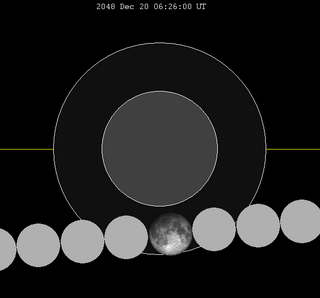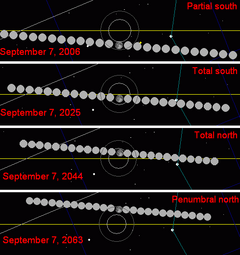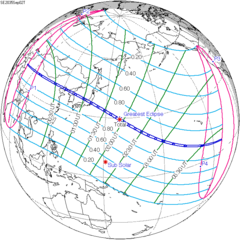
A partial lunar eclipse took place on 16 August 2008, the second of two lunar eclipses in 2008, with the first being a total eclipse on 20 February 2008. The next lunar eclipse was a penumbral eclipse occurring on 9 February 2009, while the next total lunar eclipse occurred on 21 December 2010.
A penumbral lunar eclipse took place on Thursday, March 3, 1988, the first of two lunar eclipses in 1988, the second being on August 27, 1988. Earlier sources compute this as a 0.3% partial eclipse lasting under 14 minutes, and newest calculations list it as a penumbral eclipse that never enters the umbral shadow. In a rare total penumbral eclipse, the entire Moon was partially shaded by the Earth, and the shading across the Moon should have been quite visible at maximum eclipse. The penumbral phase lasted for 4 hours, 53 minutes and 50.6 seconds in all, though for most of it, the eclipse was extremely difficult or impossible to see. The Moon was 2.2 days after apogee, making it 6.1% smaller than average.

A partial lunar eclipse will take place on Friday 28 August 2026. The moon will be almost be inside the umbra, but not quite be contained within the umbral shadow at greatest eclipse.

A penumbral lunar eclipse will take place on Tuesday, August 17, 2027. It will cause a subtle dimming as 54.56% of the Moon will cross within Earth's penumbral shadow.
A partial lunar eclipse will take place on November 8, 2041.

A penumbral lunar eclipse will take place on June 15, 2049.

A total lunar eclipse will take place on January 1, 2048. It will be the first recorded lunar eclipse to be visible on New Year's Day for nearly all of Earth's timezones. The next such eclipse will occur in 2094.

A partial lunar eclipse will take place on January 22, 2046.

A penumbral lunar eclipse will take place on March 3, 2045.

A total lunar eclipse will take place on September 19, 2043.

A total lunar eclipse will take place on March 13, 2044.

A total lunar eclipse will take place on March 25, 2043.

A partial lunar eclipse will take place on July 18, 2046.

A penumbral lunar eclipse will take place on December 20, 2048.

A partial lunar eclipse will take place on June 26, 2048. The Moon will be strikingly shadowed in this deep partial eclipse lasting 2 hours and 39 minutes, with 63.88% of the Moon in darkness at maximum.

A total lunar eclipse will take place on January 12, 2047.

A penumbral lunar eclipse will take place on May 17, 2049.

A total lunar eclipse will take place on May 6, 2050.

A total lunar eclipse will take place on April 26, 2051.

A total lunar eclipse will take place on October 30, 2050.









































